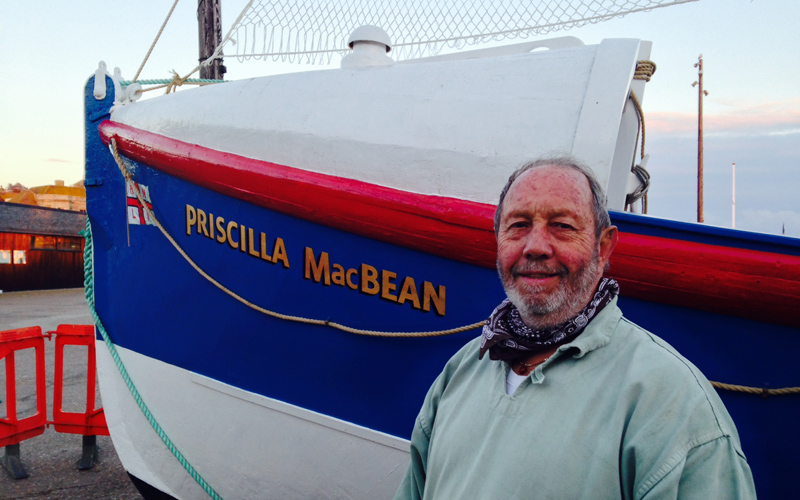Priscilla MacBean, the lifeboat that operated out of Eastbourne between 1921 and 1934 and was sister ship to Rye Harbour’s Mary Stanford, is to find a permanent dry dock in Hastings. The Mary Stanford was lost with all her 17-member crew in 1928, one of the worst lifeboat disasters in British shipping history.
Both lifeboats were made in the Isle of Wight by Samuel White to the same design, although Priscilla was supplied with a motor. Because the English Channel creates short, sharp choppy waters, Priscilla was quickly found to be unsuitable for local patrols, as her narrow 8ft 3in width combined with the water conditions to make her unstable in rough seas. This could well have been a problem that afflicted Mary Stanford, according to Dee-Day White, the Hastings Old Town resident who discovered the old lifeboat rotting in a field near Eastbourne and led the restoration work.
Priscilla was relocated to Scotland where the longer seas suited her better and she made most of her 25 rescues there. Decommissioned in 1934 and following a spell in France, she found a new lease of life as a houseboat on Lake Windermere. On returning to Eastbourne she was gutted and left to rest on the beach for a few years before being sold to a farmer who planned to roll her over and make her into a shed or chicken coop.
Fortunately, Priscilla was too heavy to roll and she lay in a field undisturbed for 19 years before Dee-Day found her by chance. He immediately began to enlist the help and support of everyone he knew, and many he didn’t. Initially, Eastbourne contacts were uncomfortable about the project as they saw Priscilla as their boat, nothing to do with Hastings. But they soon became enthusiastic, happy that their boat was being restored to glory – and the links with Mary Stanford made Hastings seem a perfect location for Priscilla to spend her twilight years.
The restoration work has taken almost a year and cost barely £10,000. This is thanks to the generosity and support of local businesses and individuals who donated labour and materials. Throughout the project, Dee-Day has come across many happy coincidences and stories connected with the boat. When the electrician came to power up the dry dock, Dee-Day told him what it was being used for only to find that the electrician’s father had been rescued by Priscilla. The electrician waived his charges. He wouldn’t have existed without Priscilla.
Dee-Day has had one or two brushes with the police in the course of the restoration. A local haulage firm agreed to collect the boat from the field, but due to her length her rear end hung over the back of the truck. Police stopped the truck as they were concerned about safety and, on hearing the story, decided to give Priscilla an escort service back to Hastings. On another occasion, a friend told Dee-Day that the local police had been sniffing around Priscilla on the beach and he was wanted up at the station. When he got there, they presented him with several hundred pounds to help with her face lift.
People from all over the country have rallied around to help the restoration. One man offered a porthole that had belonged to the boat when she had been a houseboat in Cumbria. Another had the original stone water bottle that Priscilla carried when she set out to sea.
When Dee-Day was a teenager (he was born on June 6, 1944) he picked up a piece of salvage on Hastings beach, a discarded plaque from the old lifeboat station. It was a rope design with a lifeboat inside – and, yes, the boat was Priscilla herself. Young Dee-Day took it home to his father’s pub where it was displayed for many years before finding its way back to the new RNLI station on the Stade.
On Saturday November 15 Priscilla will make her final journey from the Stade through the Old Town to her dry dock at the bottom of Old London Road. The ceremony will begin at 9am with a maroon call, a dedication and the stories of her life and that of Mary Stanford. The boat will be christened with champagne by a descendant of one of the brave men that went down at Rye Harbour in 1928. The Mayor of Hastings, Councillor Bruce Dowling, who has acted as Patron of the restoration project, was previously earmarked to perform this task, but when he heard that the great-great-great-grandson of one of these heroes was available, immediately insisted on standing down in his favour. Rye’s mayor, Councillor Bernadine Fiddimore, will also be there.
For the full agenda of Saturday’s ceremony see the website. A service to commemorate the Mary Stanford lifeboat men will take place at Rye Harbour church on Sunday November 16 at 3pm.
Photo: Seana Lanigan



